| |||||
| Decades: | |||||
|---|---|---|---|---|---|
| See also: | Other events of 1782 History of France • Timeline • Years | ||||
Events from the year 1782 in France :
| |||||
| Decades: | |||||
|---|---|---|---|---|---|
| See also: | Other events of 1782 History of France • Timeline • Years | ||||
Events from the year 1782 in France :


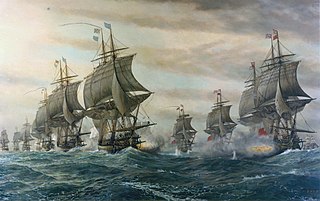
The Battle of the Chesapeake, also known as the Battle of the Virginia Capes or simply the Battle of the Capes, was a crucial naval battle in the American Revolutionary War that took place near the mouth of the Chesapeake Bay on 5 September 1781. The combatants were a British fleet led by Rear Admiral Sir Thomas Graves and a French fleet led by Rear Admiral François Joseph Paul, the Comte de Grasse. The battle was strategically decisive, in that it prevented the Royal Navy from reinforcing or evacuating the besieged forces of Lieutenant General Lord Cornwallis at Yorktown, Virginia. The French were able to achieve control of the sea lanes against the British and provided the Franco-American army with siege artillery and French reinforcements. These proved decisive in the Siege of Yorktown, effectively securing independence for the Thirteen Colonies.
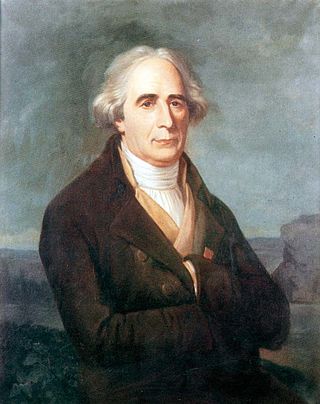
The Montgolfier brothers – Joseph-Michel Montgolfier and Jacques-Étienne Montgolfier – were aviation pioneers, balloonists and paper manufacturers from the commune Annonay in Ardèche, France. They invented the Montgolfière-style hot air balloon, globe aérostatique, which launched the first confirmed piloted ascent by humans in 1783, carrying Jacques-Étienne.

The Battle of the Saintes, also known as the Battle of Dominica, was an important naval battle in the Caribbean between the British and the French that took place 9–12 April 1782. The British victory was considered their greatest over the French during the American Revolutionary War.

Ville de Paris was a large three-decker French ship of the line that became famous as the flagship of De Grasse during the American Revolutionary War.

The Battle of Fort Royal was a naval battle fought off Fort Royal, Martinique in the West Indies during the Anglo-French War on 29 April 1781, between fleets of the British Royal Navy and the French Navy. After an engagement lasting four hours, the British squadron under Admiral Samuel Hood broke off and retreated. Admiral de Grasse offered a desultory chase before seeing the French convoys safe to port.

French involvement in the American Revolutionary War of 1775–1783 began in 1776 when the Kingdom of France secretly shipped supplies to the Continental Army of the Thirteen Colonies when it was established in June 1775. France was a long-term historical rival with the Kingdom of Great Britain, from which the Colonies were attempting to separate.

HMS Ardent was a 64-gun third-rate ship of the line of the Royal Navy. She was built by contract at Blaydes Yard in Hull according to a design by Sir Thomas Slade, and launched on 13 August 1764 as the first ship of the Ardent-class. She had a somewhat turbulent career, being captured by the French in the action of 17 August 1779, and then re-captured by Britain in 1782.

Louis-Philippe de Rigaud, Marquis de Vaudreuil was second in command of the French squadron off America during the American Revolutionary War.

The Languedoc was a 80-gun ship of the line of the French Navy and flagship of Admiral d'Estaing. She was offered to King Louis XV by the Languedoc, as part of the Don des vaisseaux, a national effort to rebuild the navy after the Seven Years' War. She was designed by the naval architect Joseph Coulomb, and funded by a don des vaisseaux donation from the Estates of Languedoc.
Caton was a 64-gun ship of the line of the French Navy, launched in 1777.
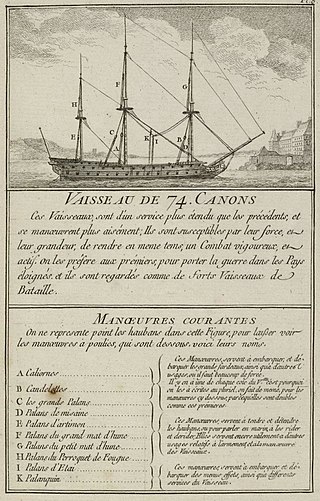
Diadème was the lead ship of the Diadème-class 74-gun ship of the line of the French Navy.

Neptune was a 74-gun ship of the line of the French Navy.

Charles-Henri-Louis d'Arsac, chevalier de Ternay was a French naval officer. Most active in the Seven Years' War and the War of American Independence, Ternay was the naval commander of a 1762 expedition that successfully captured St. John's Newfoundland. He was appointed commander of the Marine Royale, French naval forces, as part of the project code named Expédition Particulière that brought French troops to American soil in 1780. He died at Hunter House on Washington Street, which was headquarters for the French fleet in Newport, Rhode Island.
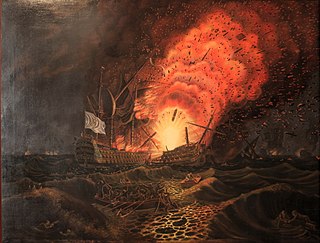
César was a 74-gun ship of the French Navy. Ordered in the spring of 1767 from the Toulon shipyard, she was launched on 3 August 1768. César saw service in the American War of Independence, during which she was destroyed in the Battle of the Saintes.
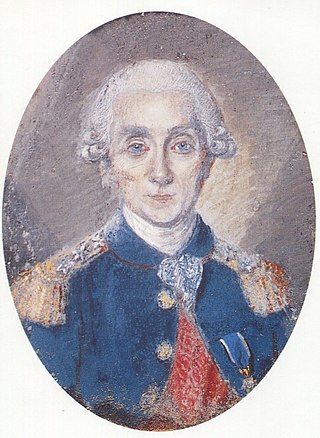
Charles René Dominique Sochet, Chevalier Destouches, also often spelled Des Touches, was a Chef d'Escadre in the French Navy. He is most widely known for his participation in the War of American Independence, where he saw action in the Battle of Cape Henry in 1781 and in the Battle of the Saintes in 1782.

The Battle of the Mona Passage was a naval engagement on 19 April 1782 taking place in the aftermath of the Battle of the Saintes between Britain and France during the American Revolutionary War. A British fleet under Rear-Admiral Sir Samuel Hood, pursued a small French fleet under Georges-François de Framond which had managed to escape the victorious British fleet a week earlier. The two fleets met and engaged at the Mona Passage where the British overtook and captured four French ships, two of which were 64-gun ships of the line.
The French cutter Espion was a cutter launched in 1781. The British captured her and took her in 1782 into the Royal Navy as HMS Espion. The Royal Navy sold her in 1783.
Events from the year 1793 in France.
Events from the year 1759 in France. France is a major participant in the Seven Years' War and its North American theater, the French and Indian War.
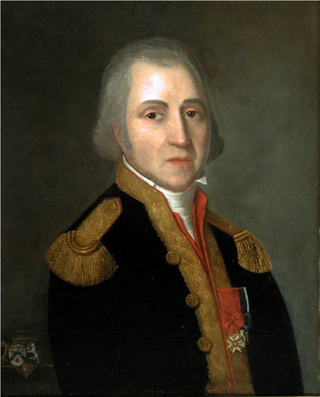
Étienne Marc Antoine Joseph de Grasse-Limermont was a French Navy officer. He took part in the War of American Independence, earning a membership in the Society of Cincinnati. A Royalist, he betrayed France and was an aid to Trogoff when he surrendered Toulon and its fleet to the British. He remained employed by the British until 1814.